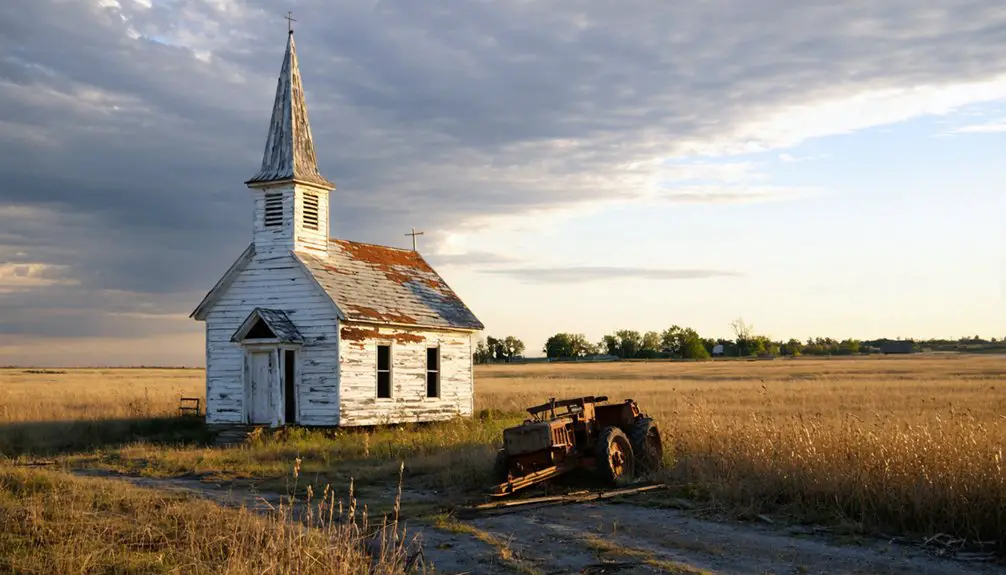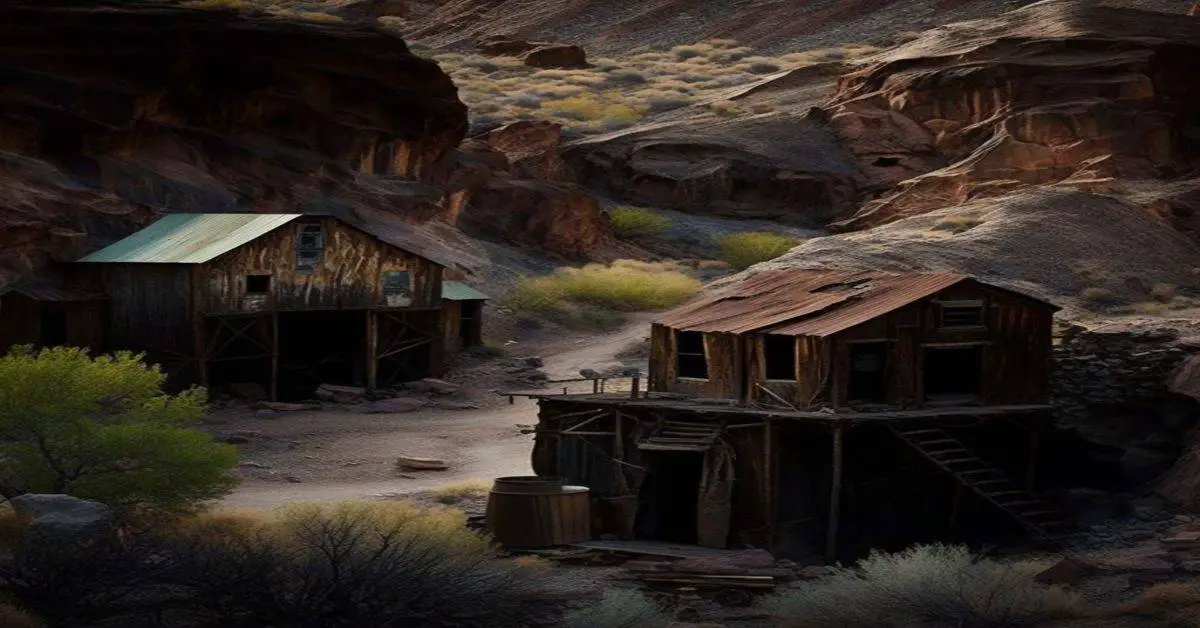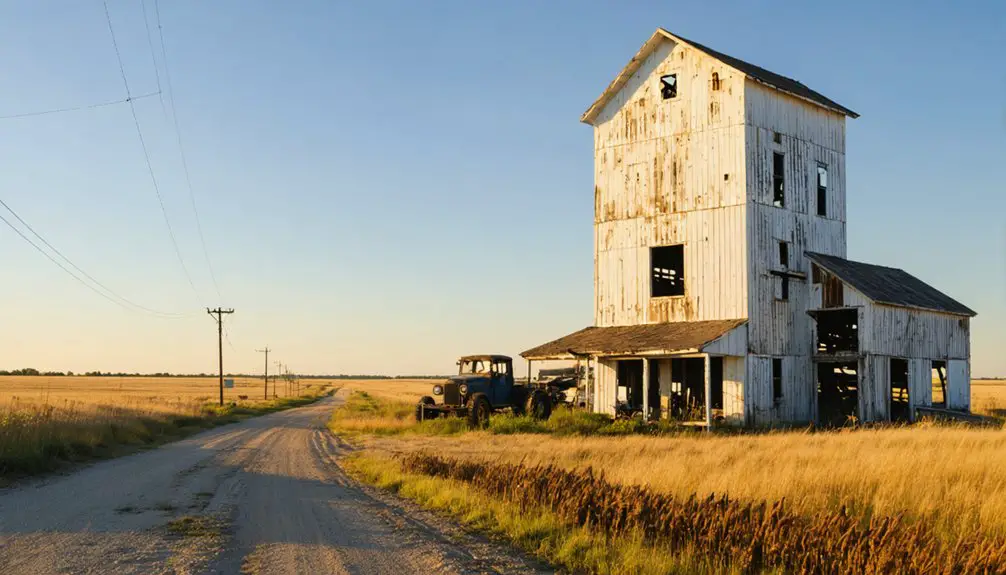You’ll find Temple in Williams County, North Dakota, where the Great Northern Railroad established it as a strategic stopover. The town thrived with essential services, reaching 90 residents by 1920, but faced decline during the Great Depression and Dust Bowl years. By 1960, only 25 people remained, and the post office’s closure in 1965 marked the community’s downturn. Temple’s story mirrors countless small railroad towns whose physical structures have vanished, but whose heritage endures through preserved artifacts and memories.
Key Takeaways
- Temple was established by Great Northern Railroad as a strategic stopover in Williams County, North Dakota, serving early settlers and farmers.
- The town reached its peak population of 90 residents in 1920 before declining to 25 by 1960.
- The closure of Temple’s post office in 1965 marked a significant milestone in the town’s abandonment.
- Economic challenges, including railroad changes and agricultural mechanization, led to Temple’s eventual transformation into a ghost town.
- The town’s cemetery remains maintained by descendants, preserving Temple’s cultural heritage despite the loss of physical structures.
Origins and Early Settlement
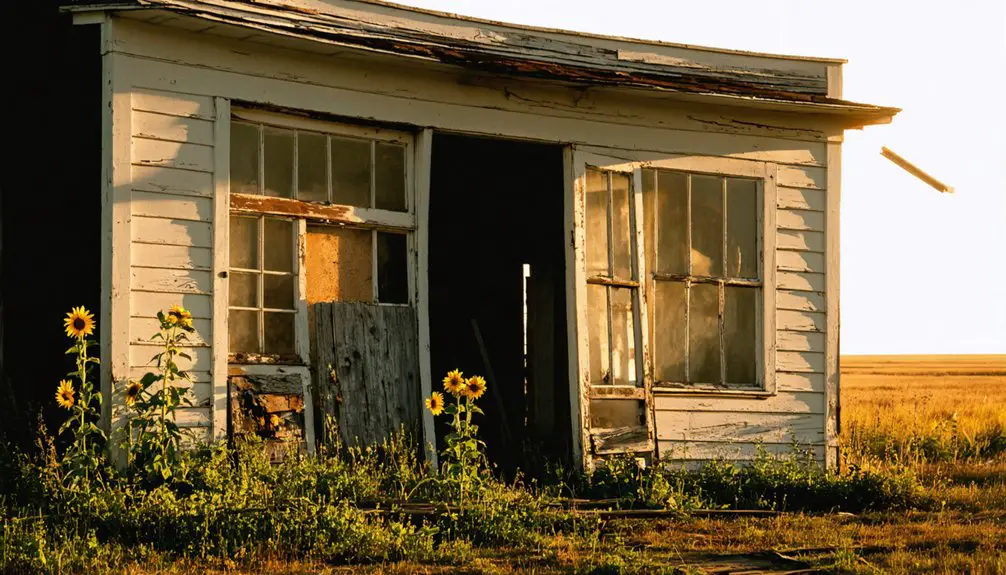
While many North Dakota towns emerged along railroad lines in the early 1900s, Temple’s story began when the Great Northern Railroad established a strategic stopover point in Williams County.
The community dynamics quickly took shape as early settlers, drawn by the promise of commerce and connectivity, built the foundations of their new home. Like Blabon’s peak population of 150 residents in 1914, Temple experienced steady growth during its early years. Much like the Atkinson Schoolhouse that was moved to Griffin proper in 2023, Temple’s buildings were positioned to serve the growing population.
You’ll find that Temple’s pioneer spirit manifested in its essential infrastructure – a post office relocated from Haarstad in 1908, a railroad depot, and buildings that served the growing population.
Early landowners, whose family members now rest in the local cemetery, helped establish Temple as a hub for homesteaders and workers.
The town’s layout reflected typical settlement patterns, with the school and church serving as anchors for the burgeoning community.
Population Rise and Peak Years
Temple’s growth accelerated in the early 1900s as settlers established farms and small businesses in the area.
You’ll find that the town reached its peak population of approximately 90 residents in 1920, when the community bustled with essential services centered around its post office.
The population’s subsequent decline through the Great Depression years of the 1930s mirrors the fate of many small North Dakota towns, ultimately dwindling to just 25 residents by 1960. The harsh conditions of the Dust Bowl contributed significantly to the exodus of farming families from the region. Today, Temple’s abandoned structures include an old church and school, standing as silent reminders of its past.
Early Settlement Growth Era
As settlers pushed northward into Williams County in the early 1900s, Temple emerged as a promising settlement along the Great Northern Railroad line. Settlement patterns followed the region’s rich agricultural potential, with farmers drawn to the fertile soil of the Red River Valley.
You’d have found a diverse mix of settlers, including Métis, French-Canadian fur traders, and Anglo farmers from southern Minnesota. Like many areas of North Dakota during this era, Temple saw a significant influx of German-Russian immigrants who established farming communities.
The town’s growth accelerated after the post office relocated from Haarstad in 1908, establishing Temple as a significant communication hub. Agricultural practices centered on wheat cultivation, supported by local milling operations and trade facilities.
The community’s strategic location near rail and river transport routes gave farmers essential market access, while religious institutions and basic services fostered a strong sense of cultural identity.
Peak Population in 1920
The year 1920 marked Temple’s population zenith, with historical records showing between 90 and 150 residents calling the settlement home.
You’d have found a vibrant mix of cultures during this peak, reflecting North Dakota’s rich demographic diversity, with many residents speaking both English and their ancestral languages. Like many parts of the state, Temple’s growth was driven by railroad expansion that brought settlers westward.
During Temple’s heyday, you would’ve experienced:
- A bustling rural community where over half the population were newcomers who’d arrived within the previous decade
- A strong immigrant presence that shaped the town’s cultural identity
- Growing connectivity through telephone lines reaching 41% of area farms
- An agricultural economy that drew settlers seeking independence and opportunity
These population estimates paint a picture of Temple at its height, before economic shifts and the Great Depression would trigger its decline.
Declining Population Trends
Following its peak population in 1920, dramatic demographic shifts began reshaping Temple’s community landscape, with numbers falling from approximately 90 residents to just 25 by 1960.
You’ll find Temple’s story mirrors many rural North Dakota communities of that era, where population migration steadily drained small towns of their liveliness. The mounting rural challenges included mechanized farming that reduced labor needs, while economic opportunities in urban centers lured younger generations away.
By 1965, Temple’s post office closed – a clear signal of the town’s decline.
The broader context shows North Dakota’s statewide population dropping from 680,000 in 1930 to 617,761 by 1970, with small towns bearing the heaviest losses.
Temple’s final abandonment in the late 20th century marked the end of its community life.
Economic Challenges and Decline
During Temple’s critical period of decline, multiple economic pressures converged to seal the town’s fate. You could trace the community’s downfall to several key economic factors, from the collapse of single-industry dependence to the broader shifts in North Dakota’s agricultural landscape.
The town exemplified what experts call a shadow of itself, reflecting the devastating economic transformation that swept through the region.
Market centralization drew commerce away as larger towns attracted chain stores and better services.
- Temple’s economy couldn’t survive the one-two punch of railroad changes and the rise of automobile transport in the 1920s.
- Agricultural mechanization meant fewer farm families needed local services.
- The town’s business district crumbled as “Mom and Pop” stores couldn’t compete with larger markets.
- When local grain elevators and rail connections disappeared, Temple lost its economic purpose as a trade center.
Structural Legacy and Lost Buildings

As years of abandonment take their toll, Temple’s structural legacy has dwindled to near-archaeological status, with most iconic buildings now lost to time and the elements.
You’ll find few traces of the once-vibrant community’s architectural significance, as both the church and schoolhouse have vanished from the landscape. The church’s bell tower, once a proud landmark, lay detached on the ground before its ultimate disappearance.
Much like railroad towns Arena and Freda, Temple’s remaining structures reflect the widespread decline of rural settlements. Structural decay has accelerated throughout Temple’s remaining buildings, surpassing the deterioration seen in many other North Dakota ghost towns. The process of demolition by decay continues unabated, leaving only fragments of the town’s former identity.
Unlike places such as Brantford, where some structures still stand, Temple’s physical remnants are scarce. With private ownership limiting access and no preservation efforts in place, you’re witnessing the final stages of a plains town’s transformation into historical memory.
Historical Documentation and Research
Three primary sources anchor Temple’s historical documentation: the North Dakota Historical Society newspaper archives, county courthouse records, and post office establishment data.
Through careful archival research, you’ll find a rich tapestry of Temple’s past preserved in these collections. Most of Temple’s buildings were removed as the town deteriorated over the past 10-15 years.
Dedicated research within these vital archives reveals the intricate historical threads woven through Temple’s documented past.
For those pursuing historical preservation of Temple’s story, here are key research discoveries:
- Early 1930s canceled checks from Temple’s school provide detailed financial insights into the community’s education system.
- Post office records confirm Temple’s 1908 establishment when it relocated from Haarstad.
- Cemetery records maintained by local genealogical societies verify community timelines.
- The railroad depot’s relocation to a nearby farm is documented through local records and oral histories.
Cultural Impact and Heritage Value
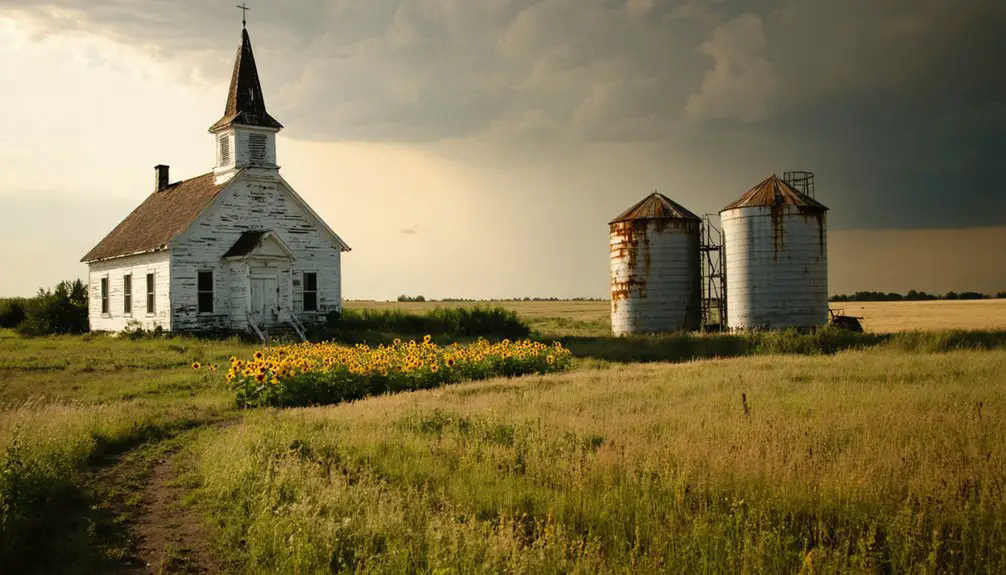
You’ll find Temple’s cultural heritage most poignantly reflected in the loss of its church and schoolhouse, which once served as essential centers of spiritual and educational life for the community’s peak population of 90 residents.
The preservation of Temple’s cemetery by descendants and local families shows how educational and religious traditions continue to resonate through generational connections.
While the physical structures have largely vanished, Temple’s story captures the broader narrative of rural North Dakota’s transformation, serving as a powerful reminder of how small farming communities shaped the region’s identity.
Religious Life Fades Away
When Temple’s church burned down after being deemed unsafe, it marked a profound turning point in the ghost town’s dissolution. The loss of this religious symbolism went far beyond the physical structure – it represented the final unraveling of community cohesion that had defined Temple’s spirit for generations.
You’ll find that Temple’s religious decline followed a predictable pattern:
- Population dwindled from 90 to just 25 by 1960
- The schoolhouse, once integrated with church life, was relocated and converted to a residence
- Fewer congregants remained to maintain church activities and building upkeep
- The church’s destruction accelerated Temple’s transformation from ghost town to archaeological site
Today, only the cemetery stands as a tangible connection to the spiritual heritage that once anchored this railroad town’s identity.
Educational Legacy Lives On
Temple’s educational heritage endures through both physical remnants and cultural memory, even as the town itself has faded into history.
You’ll find evidence of educational preservation in the original schoolhouse, which now serves as someone’s home after being moved from its foundation. The building’s repurposing guarantees that this essential piece of Temple’s community identity lives on.
Inside the abandoned school, discovered artifacts like 1930s canceled checks tell stories of daily life during Temple’s heyday.
The one-room schoolhouse, typical of early rural North Dakota, represented more than just education – it was a hub of community activity.
While the town’s physical structures have largely disappeared, Temple’s educational legacy continues through maintained records, family histories, and preserved artifacts that document this significant chapter of North Dakota’s rural heritage.
Rural Heritage Still Matters
The cultural fabric of rural America remains woven into Temple’s story, even decades after its last residents departed.
Through cultural preservation efforts and community memories, you’ll find Temple’s heritage living on in meaningful ways:
- The cemetery, still lovingly maintained, stands as a symbol of the enduring connection between past and present generations.
- Historical documentation, including newspaper archives and photographs, preserves Temple’s unique narrative for future study.
- Personal artifacts like 1930s canceled checks from the abandoned school provide tangible links to daily life in Temple’s heyday.
- Local descendants continue sharing oral histories, keeping the spirit of this railroad town alive through their stories.
These elements remind us that while buildings may crumble, the cultural significance of rural communities like Temple persists in both memory and meaning.
Frequently Asked Questions
Are There Any Remaining Residents Who Visit or Maintain Connections to Temple?
Primarily, you’ll find periodic pilgrims visiting the preserved cemetery, though Temple lacks local legends or regular ghost town visitors. Descendants of former residents occasionally return, but there’s no permanent population or organized maintenance.
What Natural Disasters or Significant Weather Events Contributed to Temple’s Abandonment?
You won’t find flood damage or winter storms as causes of Temple’s abandonment. The town’s decline came from economic and demographic shifts, with buildings deteriorating from neglect rather than natural disasters.
Can Visitors Legally Explore the Remaining Structures and Ruins Today?
You shouldn’t explore Temple’s remaining structures without explicit permission, as legal guidelines suggest it’s likely private property. Follow proper exploration etiquette by obtaining landowner consent to avoid trespassing charges.
Were There Any Notable Crimes or Mysterious Events in Temple’s History?
You won’t find major unsolved mysteries or crime history here – just an unsolved arson at the school building that left a hole in the basement. Most changes came from natural population decline.
What Businesses and Services Existed in Temple During Its Peak Years?
You’d have found basic services like a grocery store, post office, church, and school in Temple’s heyday. The railway supported agricultural shipping, while local businesses likely included a blacksmith shop.
References
- https://ghostsofnorthdakota892857007.wordpress.com/2004/10/04/temple-nd/
- https://ghostsofnorthdakota892857007.wordpress.com/2018/03/29/5-lost-north-dakota-places/
- https://jpipsqueak.wordpress.com/2012/11/01/temple-north-dakota-abandoned-north-dakota/
- https://www.youtube.com/watch?v=8GO57Im_dss
- https://northernsentry.com/2023/05/12/ghosts-of-north-dakota/
- https://ghostsofnorthdakota892857007.wordpress.com/2017/03/28/the-story-of-how-ghosts-of-north-dakota-began/
- https://www.youtube.com/watch?v=-E2DA6Ryd1g
- https://www.youtube.com/watch?v=MZ_xZ0d_TBY
- https://www.legendsofamerica.com/arena-north-dakota/
- https://freepages.history.rootsweb.com/~gtusa/usa/nd.htm
